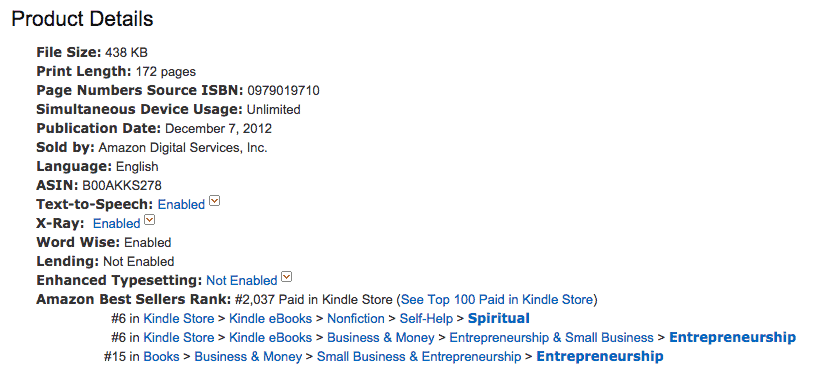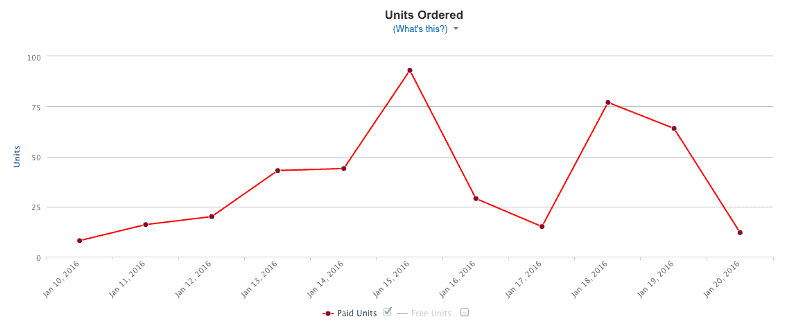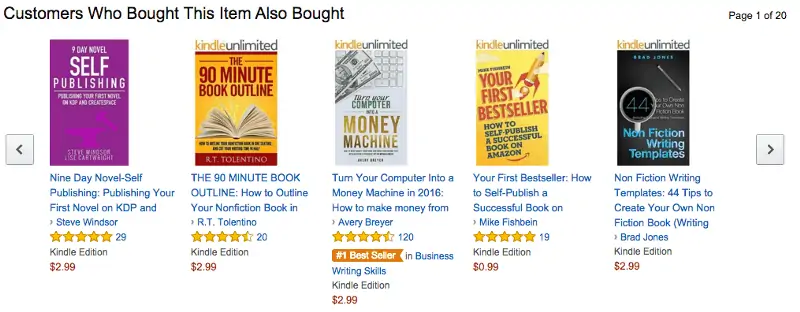Writing a book can be a great way to market yourself and even make money.
But actually finishing the steps to writing a book and achieving the results you want is much harder in practice.
In this article I’ll share the eight steps to writing a book that sells: from determining your goals to writing to marketing.
1. Determine your goals
As I mentioned, writing a book can help you achieve one or more potential goals. These goals include:
- Building your brand
- Generating leads for your business (consulting, speaking, video courses, etc.)
- Making money
The steps you take to writing your book, and your strategies for doing so, must be influenced by your goals.
Some topics are extremely competitive on Amazon. If your goal is to make money, it might not be possible if you’re writing about one of those topics. If your goal is to make money, the topic you select is far more important than if your goal is to build your brand in your industry. However if your goal is to build your brand in your industry, the topic is mostly accounted for and the competition of your topic is less important.
2. Know who your audience is
Determining your audience is more of a thought experiment than a tangible deliverable. But it’s an important thought experiment that will impact the next steps to writing your book.
Without knowing who your audience is, how can you know what or how to write? Without knowing who your audience is, how can you know how to position and market your book?
To complete the step of determining who your audience is, create a customer avatar or “persona.” This is a practice common in business, marketing and product management. Basically, it’s a fictitious representation of your target customer or reader.
If you’re writing about self-publishing on Amazon, your target audiences might include:
- Consultants and speakers looking to build their brands and generate leads
- Internet marketers who want to make money online
Go beyond the bullet points above. Write out, in as much detail as possible, the demographics of your target audience, what their goals are, what challenges they have, what’s valuable to them, and what questions they have as it pertains to the topic of your book.
As questions come up while you are writing, producing and marketing your book – as they inevitably will – think back to your personas. What would they want from your book?
3. Pick a topic
Picking book topic is about as important as picking a business idea. It requires finding a balance between supply and demand – finding a topic that your audience wants to read about but that there’s not too much competition for.
It’s ok if there’s competition if there’s enough demand. In fact, having some competition is indication that there is demand. Lack of demand is a big reason why businesses, and books, fail.
The topic must also be tied to your goals. If your goal is to market your marketing consulting business, you wouldn’t write a book about monkeys.
So, to pick a topic for your book, think about what challenges and questions your target audience has. What are they actively searching for on Google? What are they already buying on Amazon?
Browse Amazon. Look at the rankings of other books on your topic. Look at the appropriate category for your book. How well are the bestsellers in those categories doing?
If your goal is to make money, find gaps on Amazon. If your idea doesn’t meet an unmet need, it will be harder to make consistent income from it. But if you find a topic that’s valuable to your target audience and balances supply and demand on Amazon, you’re in a great place.
4. Write your book
Some people like to set goals and form habits. If that works for you, eat your heart out. Maybe your goal will be to write 10,000 words by December 1st. Maybe your habit will be to wake up at 6am and write 1,000 words every morning.
I, however, prefer to build systems. To do this, I started by determining my “ends goals.” My ends goals are to be healthy (mentally and physically) and helpful – and writing helps me achieve both of those. I remind myself of those ends goals all the time. Doing so keeps me motivated and energized.
Then, I determined, through various experiments, when and how I do my best writing. It’s in the morning. So, I focus on creating a system that enables me to write in the morning and executing on the “inputs” that can enable it to happen. The inputs include getting high quality sleep, eating healthy, exercising, not overcommitting myself personally or professionally, and being around people I love.
In terms of the actual content of your book, be sure to provide value to your target audience, in the form of education and/or entertainment. The more readers like your book, the more good reviews you will get on Amazon. The more good reviews you get on Amazon, the more books you will sell.
5. Edit and proofread
Your opinion of your book does not matter. The only opinion that matters is your reader’s.
After writing, re-writing and editing your book over and over again, you will inevitably miss some obvious shortcomings and typos.
Get your book edited for:
- Quality of content
- Style and wording
- Spelling and grammar
Get feedback from your target audience on the content. How helpful was it? What questions do they still have about the topic?
Hire an editor/proofreader for style, wording, spelling and grammar.
Readers will take any excuse they can get to leave a bad review for your book. Make sure your book is crystal clean. By getting your book edited for all of the above, you’re more likely to get good reviews.
6. Produce your book
You could have the best written book with the most valuable content – and even do the best marketing in the word – but if people who landed on your book page aren’t compelled to buy it will all be a waste.
When a potential reader lands on your book page on Amazon, there are a few factors they have to look at in order to make their decision on whether or not to buy your book. These are:
- Title
- Description
- Cover design
- Reviews
Write a title that piques interest, describes what the book is actually about, and displays the value the reader will gain from reading it. Bonus points if it contains keywords that help you rank in Amazon’s search results. You can read my best advice on writing a book title here. If you’re stuck, use PickFu to split test.
Your book description should not be a list of the topics covered in your book or a brief summary. It’s purpose is to sell! Read my best advice for writing a book description here.
Design a cover that grabs attention and looks professional. Look at the covers of books in your niche that are performing well. Use a similar style…but make it much better! Ask friends and colleagues if they know a designer who’s designed book covers before. Look at their work before hiring them. Give the designer detailed instructions on what you want, what other covers you like, and give them feedback on their first draft.
I’ll talk about getting reviews in the book marketing section at the end of this article.
7. Self-publish your book
Authors are not limited to writing ebooks or waiting for a big publisher to choose their book. The amazing self-publishing platforms of today give authors access to the following formats:
I’ve created comprehensive and step-by-step guides to self-publishing your book on these platforms so I’ve linked to them above. I won’t cover that all again here. But if after reading the above guides, you still have questions, leave a comment below and I’ll do my best to help.
8. Market your book
It doesn’t matter how amazing your book is – if know one knows about it, no one will buy it.
There are two pieces of book marketing that need to be done right in order to get results: traffic and conversion.
The conversion part is covered in step #6 above on producing your book’s title, description and cover. So I’ll focus on traffic here.
If you don’t already have a big audience or email list, your best source of traffic to your book will probably be Amazon itself. But Amazon doesn’t promote every one of the gazillion books on it’s platform. Amazon promotes the books that will help the company make money. It promotes the books that their users actually buy.
How does Amazon know if your book is one of the good ones? It looks at factors like reviews and downloads. You can leverage book promotion sites to get downloads. Check out my case study on book marketing here to learn how to make all that happen.
But for significant success over the long-term, you will need a “platform.” Build an email list. How can you get people onto your email list? Try one or more of the below depending on what your audience uses and the level of competition for each in your particular industry:
- Google (search engine optimization)
- Podcast
- YouTube
- Social media
- Medium.com
My #1 piece of advice for getting good reviews is simply to write a great book. Without that step, none of the rest of these steps to writing a book that sells really matter over the long run.
If you want more detailed instructions on writing a book that sells, download the checklist below. Happy writing!











